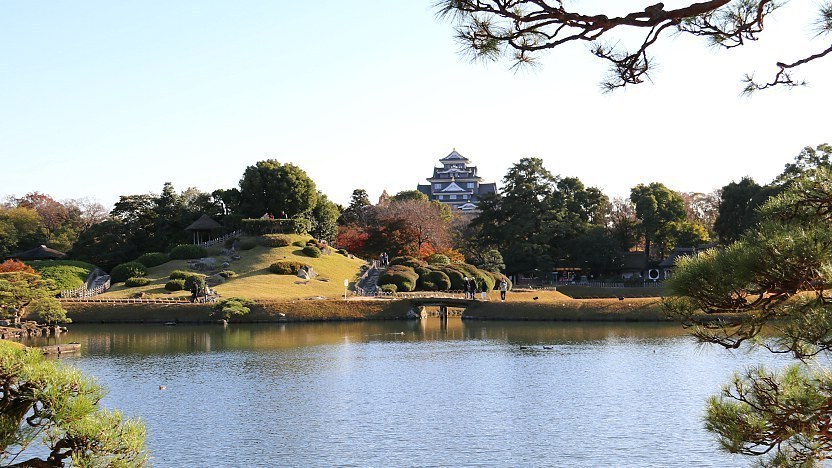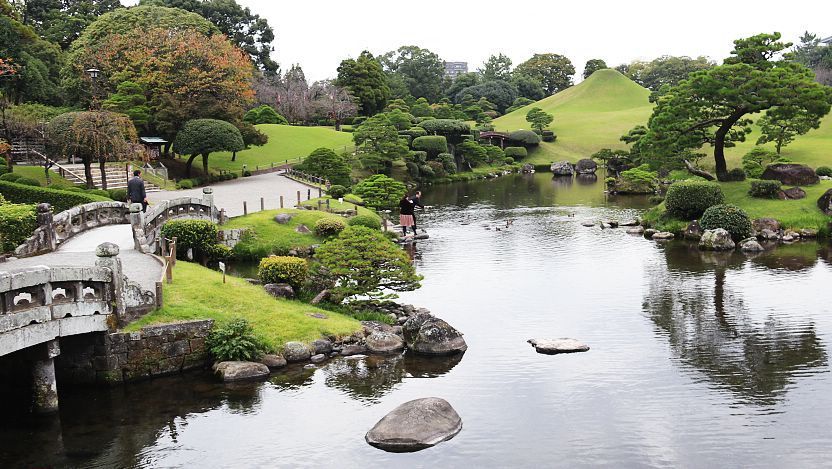Types of Gardens

Gardens have been built throughout history usually by the leading classes - aristocrats, monks, warriors, politicians and industrialists - for various purposes, such as recreational enjoyment or religious fulfillment. The evolution of gardens can be roughly aligned with Japan's historical periods whose contemporary cultural and religious characteristics are reflected in the various garden types. While some of these garden types have disappeared, others live on today.
Early Japan (before 794)
One of the earliest garden forms in Japan were sacred places in the midst of nature, which humans marked by pebbles. Predating the introduction of Chinese culture from the mainland, this early garden form can be recognized at some ancient Shinto shrines, for example at the Ise Shrines, whose buildings are surrounded by wide pebbled areas.

The widespread adoption of Chinese culture and Buddhism from the 6th century on heavily influenced Japanese garden design. During this era, gardens were built at imperial palaces for the recreation and entertainment of the emperor and aristocrats. They introduced ponds and streams as their focal points, contained many Buddhist and Taoist elements and attempted to reproduce famous landscapes.
Unfortunately none of these early palace gardens survive. However, based on archaeological findings in Nara, the East Palace Garden at Heijo Palace was meticulously reconstructed and opened to the public in the 1990s and provides visitors with a good idea of these early types of palace gardens.

Heian Period (794-1185)
At the start of the relatively peaceful Heian Period, the capital was moved to Kyoto where the aristocrats devoted much of their time to the arts. They began building Shinden Gardens at their palaces and villas, large gardens which were used for elaborate parties and for recreational activities such as boating, fishing and general enjoyment.
Shinden Gardens were described in detail in the classic novel "Tale of Genji". Designed after Chinese concepts, the gardens featured large ponds and islands connected by arched bridges under which boats could pass. A gravel covered plaza in front of the building was used for entertainment, while one or more pavilions extended out over the water. No Shinden Garden survives today, but some of their large ponds are found incorporated into later gardens, e.g. Osawa Pond at Daikakuji Temple in Kyoto.

In the late Heian Period, Pure Land Buddhism gained popularity, promising its devotees a spot in the the Western Paradise of the Amida Buddha or Pure Land. Consequently, gardens were built to resemble that Buddhist paradise. Similar in design to Shinden Gardens, they featured a large pond with lotus flowers and islands, as well as beautiful pavilion buildings.
No complete Pure Land Garden survives, however, Uji's Byodoin Temple and Hiraizumi's Motsuji Temple preserve many major elements of the garden type. Elements of a Pure Land Garden also survive at the Shiramizu Amidado in Iwaki.

Kamakura and Muromachi Periods (1192-1573)
At the beginning of the Kamakura Period a shift of power from the aristocratic court to the military elite was completed. The military rulers embraced the newly introduced Zen Buddhism, which would exert a strong influence on garden design. Gardens were often built attached to temple buildings to help monks in meditation and religious advancement rather than for recreational purposes.
Gardens also became smaller, simpler and more minimalist, while retaining many of the same elements as before, such as ponds, islands, bridges and waterfalls. The most extreme development towards minimalism was the Karesansui Dry Garden which uses nothing but rocks, gravel and sand to represent all the elements of the garden landscape.
Many gardens from this period still survive in Japan, especially in Kyoto's leading Zen temples, such as Ryoanji, Daitokuji, Tenryuji and Kokedera. Some older examples are also found in Kamakura, including the early Zen gardens of Zuisenji and Kenchoji.

Azuchi-Momoyama Period (1573-1603)
Tea gardens (Chaniwa) had already appeared in previous periods for holding the tea ceremony, but they reached the height of their development during the Azuchi-Momoyama Period when the contemporary tea masters refined and perfected their design and imbued them with the spirit of "wabi" or rustic simplicity, for which they are recognized today.
Tea gardens are simple and utilitarian. A stepping stone path leads from the entrance to a tea house. Stone lanterns provide lighting and a decorative element, while a wash basin (tsukubai) is used for ritual cleansing. Many tea gardens can be found in Japan today, although many of them are incorporated into larger garden designs.

Edo Period (1603-1867)
During the Edo Period, garden design departed from the minimalism of the Muromachi Period as the ruling class rediscovered its likings for extravagance and recreation. The product were large strolling gardens with ponds, islands and artificial hills that could be enjoyed from viewpoints along a circular trail. Many strolling gardens also included elements of tea gardens.
The regional feudal lords constructed strolling gardens both in their home towns and at their secondary villas, which they were required to maintain in Edo (current day Tokyo). Therefore, strolling gardens today can typically be found in former castle towns and scattered around Tokyo. Among the most celebrated strolling gardens are Kanazawa's Kenrokuen, Okayama's Korakuen, Takamatsu's Ritsurin Koen, Kyoto's Katsura Imperial Villa and Tokyo's Rikugien and Koishikawa Korakuen.

In contrast, Tsuboniwa are small gardens that became popular among the urban population. These mini gardens (tsubo refers to the area of two tatami mats) filled in the small courtyard spaces within or between townhouses and provided a touch of nature as well as light and fresh air. Due to their size, they usually featured just a small amount of decorative elements and were not meant to be entered.
Tsuboniwa can be seen in some of the historic merchant residences that are open to the public. They also remain a popular type of garden today among people who wish to incorporate a small green space into their homes, but lack the luxury of abundant space.

Modern Gardens (1868 to present)
In the Meiji Period, Japan entered an age of rapid modernization and Westernization. Western-style city parks were built, and many of the formerly private strolling gardens were opened to the public. Politicians and industrialists were the force behind the construction of new private strolling gardens which often contained Western elements such as flower beds and lawns. Many of these gardens were built in the new capital of Tokyo, for example the Kiyosumi Teien.
Some modern garden designers also tried their hand at creating more traditional types of Japanese gardens, although they often included some new ideas into them. Good examples are the Zen gardens of the Tofukuji Temple in Kyoto and the stone garden in the back of Kongobuji Temple on Koyasan which date from the 1930s or the even more recent gardens of the Adachi Art Museum near Matsue.

Questions? Ask in our forum.